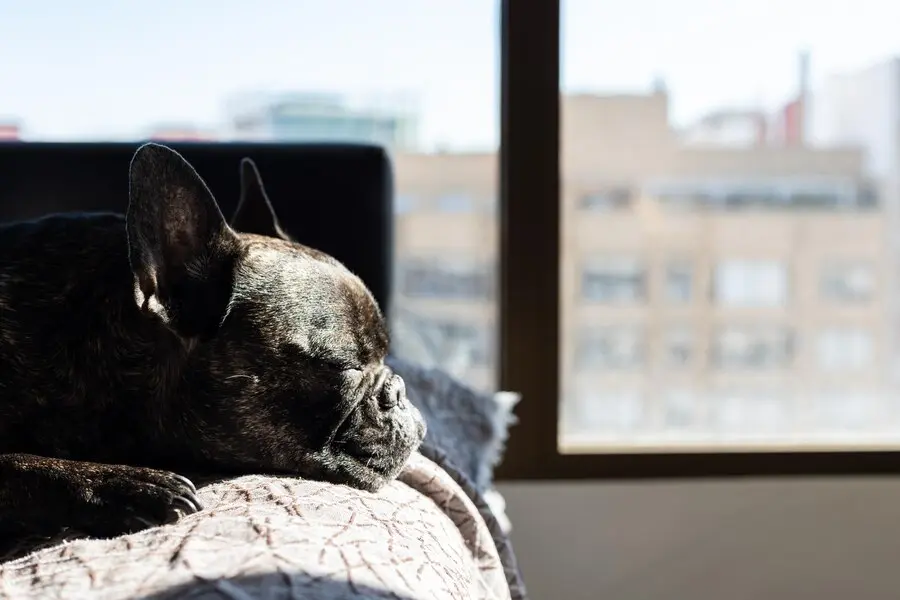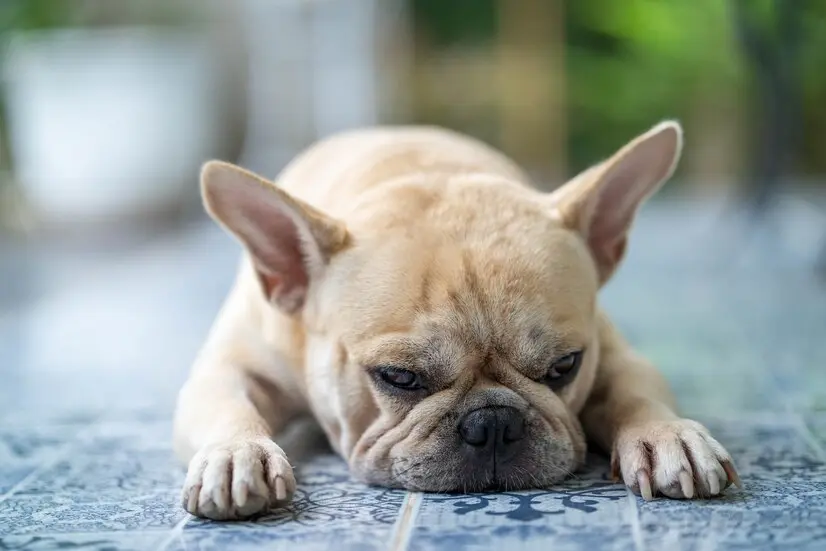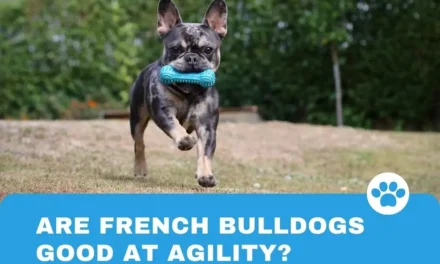Can French Bulldogs Be Left Alone?

Diving into the world of French Bulldog companionship brings forth a common concern: Can French Bulldogs be left alone?
“Yes, French Bulldogs can be left alone, but it’s crucial to understand their needs. Create a comfortable environment, use technology, and train gradually for a positive experience.”
It’s a question that resonates with pet owners seeking to understand the dynamics of caring for these charming canines. In this exploration, we unravel the intricacies of solo time for French Bulldogs, delving into their social needs, behaviors, and practical strategies.
Whether you’re a prospective Frenchie parent or a seasoned owner, this guide aims to shed light on the art of balancing independence and companionship, ensuring a happy and well-adjusted experience for both human and furry friend alike.
Are French Bulldogs Clingy?
French Bulldogs, known for their distinctive features, often raise the question of whether they are clingy due to their affectionate nature. However, labeling them as merely clingy oversimplifies their character.
Renowned for deep emotional bonds, their desire for proximity is a display of loyalty and devotion rather than dependency. French Bulldogs seamlessly integrate into their families, actively participating in daily life. While their affection is cherished, it may lead to separation anxiety when left alone.
Recognizing these challenges allows owners to implement strategies for a healthy emotional balance. In essence, French Bulldogs bring warmth and companionship, actively seeking to be integral parts of the lives they touch, fostering a fulfilling bond with their fortunate owners.
What are their Social Needs and Attachment to Owners?

One of the defining characteristics of French Bulldogs is their strong desire for social interaction. These dogs form deep bonds with their owners, seeking companionship and affection in abundance. Understanding their social needs is integral to providing a fulfilling environment that promotes their well-being.
The attachment Frenchie develops with their owners is akin to a tight-knit bond. They thrive on human connection, making them particularly sensitive to changes in their social dynamics. Consequently, the way we navigate their alone time plays a crucial role in maintaining a harmonious relationship.
What are the Common Behavioral Issues When Left Alone?
While French Bulldogs are generally amicable, leaving them alone for extended periods can pose challenges. Separation anxiety and boredom-induced behavior are common issues that may arise. This can manifest in behaviors such as excessive barking, destructive chewing, or even attempts to escape.
Understanding these potential behavioral issues is the first step toward addressing them effectively. By recognizing the signs of distress or anxiety, owners can implement strategies to alleviate these challenges, ensuring a positive experience for both Frenchie and caretaker.
Assessing Your French Bulldog’s Individual Needs

What Age Considerations should be taken into account?
Understanding the age-related nuances of your French Bulldog is crucial when evaluating their ability to be left alone. Puppies, with their boundless energy and shorter attention spans, may require more frequent interactions and shorter solo periods. On the other hand, older French Bulldogs may demonstrate a greater capacity for alone time but might need adjustments in consideration of potential health issues or reduced mobility.
Younger French Bulldogs, being in their formative stages, often crave more attention and mental stimulation. Therefore, age considerations play a pivotal role in tailoring your approach to alone time, ensuring it aligns with their developmental needs.
How does Health and Physical Condition impact their alone time?
The health and physical condition of your French Bulldog are integral factors influencing their tolerance for alone time. Brachycephalic breeds like French Bulldogs, with their distinctive short noses, may face respiratory challenges that could affect their comfort during solitary periods. Additionally, pre-existing health conditions may require specialized care and attention.
Maintaining a keen eye on their overall well-being ensures that their alone time is not only comfortable but also conducive to their health. Regular veterinary check-ups and a consideration of their physical condition are essential elements in crafting an individualized approach.
What role do Previous Experiences and Training play?
The past experiences and training history of your French Bulldog significantly impact their response to being left alone. Dogs with positive experiences during solitary periods are more likely to adapt well, while those with past trauma or negative associations may exhibit anxiety or stress.
Effective training techniques, such as gradual desensitization to alone time, can reshape their perceptions and foster a more positive outlook. Understanding their individual history allows for a tailored strategy, creating an environment where your French Bulldog feels secure and confident during moments of solitude.
Preparing Your Home

What are the considerations for Safe and Secure Spaces for Alone Time?
Ensuring a safe and secure environment is paramount when preparing your home for your French Bulldog’s alone time. Evaluate the designated space for potential hazards and remove any items that could pose a risk. French Bulldogs, with their inquisitive nature, may explore their surroundings, so securing electrical cords, toxic plants, and small objects that could be swallowed is essential.
Invest in pet-friendly gates or barriers to create a defined and secure area. This not only prevents access to potentially hazardous zones but also provides a sense of confinement that can be comforting for your Frenchie. Consider the ambient temperature of the space, as French Bulldogs are sensitive to extreme heat or cold, and ensure adequate ventilation.
What Essential Supplies and Toys are beneficial for Mental Stimulation?
Engaging your Frenchie’s intellect during alone time is crucial for their mental well-being. Opt for interactive toys that dispense treats or toys that require problem-solving skills. Puzzle feeders not only provide mental stimulation but also slow down their eating pace, promoting digestive health.
Consider rotating toys regularly to prevent boredom. Introduce new textures, shapes, and sounds to keep their curious minds engaged. Innovative toys, such as treat-dispensing balls or puzzle mats, tap into their natural instincts and provide an enriching solitary experience.
How can you create Comfortable Resting Areas for your Frenchie?
Crafting cozy resting spaces contributes to a positive alone time experience. Choose comfortable bedding that provides support and warmth. Consider the placement of the resting area; it should be away from high-traffic zones to minimize disruptions but still within earshot for a sense of connection.
Incorporate blankets or items with familiar scents to create a comforting atmosphere. French Bulldogs, known for their love of warmth, may appreciate a soft blanket or a small heated pad during colder seasons. Observing their preferences and adjusting the resting area accordingly ensures a comfortable retreat during their moments of solitude.
Gradual Alone Time Training

How do you go about Introducing Short Periods of Separation?
Introducing your Frenchie to short periods of separation requires a methodical and patient approach. Begin by choosing a quiet and secure space for their alone time. A room with minimal distractions ensures a focused training environment.
Initiate the process by leaving for brief intervals, gradually increasing the duration as your Frenchie becomes accustomed. Start with seconds, not minutes, to acclimate them without causing distress. Ensure your departure is calm and low-key, avoiding excessive farewells that might heighten anxiety.
Create positive associations by leaving enticing toys or treats. This redirects their attention, making the initial moments of separation more enjoyable. Employing a cue, such as a specific phrase or action before leaving, signals predictability and helps ease your Frenchie into the routine.
What Positive Reinforcement Techniques are effective?
Positive reinforcement is a cornerstone of successful alone time training. When your Frenchie displays calm behavior during separation, offer praise and rewards. Utilize high-value treats or toys to reinforce their positive response.
Associate your departure with positive elements by providing a special treat reserved for these moments. This creates a positive association, transforming the act of leaving into a rewarding experience. Consistency is key; reinforce positive behavior every time, gradually reducing the frequency as they become more accustomed.
How should you be Monitoring and Adjusting based on your dog’s response?
Vigilance and adaptability are crucial in monitoring and adjusting your training approach. Observe your Frenchie’s behavior during and after periods of separation. Signs of distress may include excessive barking, destructive behavior, or changes in eating habits.
If distress signals arise, consider adjusting the duration of separation or incorporating additional comfort measures. Gradually extend the time apart once your Frenchie demonstrates comfort with shorter intervals. Be attuned to their cues, adapting the training pace to match their individual needs.
Consistent monitoring allows you to identify progress and address challenges promptly. Celebrate small victories, such as moments of calmness, and adjust the training plan accordingly. Remember, every Frenchie is unique; tailoring your approach to their specific temperament ensures a positive and successful alone time training experience.
Creating a Routine

What does a Consistent Feeding and Bathroom Schedule entail?
Crafting a routine for your French Bulldog involves precision, and at its core lies a consistent feeding and bathroom schedule. This regimen instills a sense of predictability, vital for their well-being. Consistency in feeding entails serving meals at the same times daily, maintaining a balanced and nutritious diet tailored to their breed-specific needs.
Simultaneously, a meticulous bathroom schedule aligns with their biological rhythm. Recognizing their cues and establishing a routine for outdoor breaks not only aids in preventing accidents but also nurtures a disciplined approach to their bathroom habits. A harmonious cycle of nourishment and elimination lays the foundation for a content and well-regulated Frenchie.
How can you Incorporate Playtime and Exercise into their routine?
Beyond sustenance and relief, a holistic routine for your Frenchie integrates playtime and exercise, acknowledging their spirited nature. Delve into their playful tendencies by incorporating stimulating play sessions into their daily activities. Selecting toys that engage their cognitive prowess adds a layer of mental stimulation to their routine.
Consider short walks or supervised outdoor activities tailored to their moderate exercise needs. Due to their brachycephalic anatomy, activities should be paced, preventing undue respiratory strain. Adapting the playtime routine to their energy levels ensures a fulfilling experience that harmonizes with their unique temperament.
What steps are involved in Establishing a Departure and Return Routine?
For moments of solitude, creating a departure and return routine is an artful practice. Departures should be discreet, devoid of unnecessary theatrics, minimizing any potential stress for your Frenchie. A quiet exit sets the tone for a serene alone time experience.
Upon return, introduce a calm and measured reentry. This measured approach prevents excessive excitement, ensuring your arrival is woven seamlessly into their routine. Brief play sessions or displays of affection can follow, embedding positive associations with your return. This routine approach cultivates an atmosphere of stability and security.
Technology and Monitoring Tools

How can you effectively Utilize Pet Cameras for Real-Time Observation?
Pet cameras have revolutionized our way of monitoring and interacting with our furry companions. Beyond mere surveillance, these technological marvels offer real-time observation, allowing you to stay connected with your French Bulldog regardless of your physical location. Let’s explore the multifaceted ways in which you can harness the power of pet cameras for an enriching and vigilant pet-parenting experience.
Live Video Streaming:
The cornerstone of pet cameras is the ability to stream live video. This feature empowers you to observe your French Bulldog’s activities in real-time, providing a window into their world, whether it’s playful antics, peaceful napping, or unexpected mischief.
Example: Tune into the live stream during your lunch break to catch a glimpse of your French Bulldog’s midday activities, fostering a sense of connection.
Two-Way Audio Communication:
Many pet cameras offer two-way audio communication, enabling you not only to hear your French Bulldog but also to speak to them. This interactive feature facilitates real-time engagement, soothing your French Bulldog with your voice or issuing commands as needed.
Example: Comfort your French Bulldog with a reassuring voice if they exhibit signs of anxiety, reinforcing a sense of security through auditory connection.
Remote Treat Dispensing:
Some advanced pet cameras come equipped with treat dispensers, allowing you to remotely reward your French Bulldog for good behavior or simply to brighten their day. This feature adds a delightful interactive dimension to real-time observation.
Example: Dispense a treat while observing your French Bulldog’s reaction, creating positive reinforcement through virtual presence and reward.
Motion and Sound Alerts:
Pet cameras are designed to detect significant events. Motion and sound alerts notify you instantly when your French Bulldog is active or if unusual sounds are detected, ensuring you stay informed about your French Bulldog’s behavior even when you’re not actively watching.
Example: Receive an alert when your French Bulldog starts playing or vocalizing, prompting you to check in and witness these moments in real-time.
Night Vision Technology:
Real-time observation isn’t limited to daylight hours. Cameras with night vision technology ensure that you can keep an eye on your French Bulldog even in low-light conditions, providing continuous surveillance around the clock.
Example: Check in on your French Bulldog during the evening, utilizing night vision to observe their nighttime habits without disturbing their rest.
Record and Share Moments:
Pet cameras often allow you to record snapshots or video clips of memorable moments. This feature not only lets you capture adorable instances but also share them with family and friends, fostering a sense of community around your French Bulldog.
Example: Record a playful interaction and share it with loved ones, turning your French Bulldog’s daily activities into shared moments of joy.
Multiple Camera Angles:
For comprehensive coverage, some pet cameras offer the flexibility of adjusting camera angles remotely. This ensures that you can observe different areas of your home or follow your French Bulldog’s movements seamlessly.
Example: Rotate the camera to monitor different rooms, providing a holistic view of your French Bulldog’s environment and activities.
What Interactive Toys and Devices can keep them engaged during alone time?

Interactive toys and devices serve as enchanting companions for your Frenchie during moments of solitude. Opt for puzzle feeders that challenge their intellect, dispensing treats as rewards for problem-solving. Consider devices that emit soothing sounds or mimic heartbeats, providing a comforting ambiance akin to their littermates.
Novelty is key; introduce rotating toys to stave off boredom. Look for interactive balls that respond to movement, engaging your Frenchie’s playful instincts. Intelligent treat-dispensing gadgets, designed to release treats at intervals, offer both mental stimulation and a delightful reward system. These technological marvels transform alone time into an enriching and engaging experience.
Which Apps and Gadgets are useful for Remote Interaction?
In the digital realm, apps and gadgets pave the way for seamless remote interaction with your Frenchie. Explore apps that enable you to dispense treats remotely, turning your absence into a treat-filled adventure for your pup. Gadgets with laser pointers controlled via smartphone apps provide an interactive play experience, allowing you to engage your Frenchie in a game of chase from afar.
Consider smart toys equipped with cameras and features like automatic ball throwing. These gadgets not only keep your Frenchie physically active but also offer a visual connection. Choose apps that facilitate video calls, allowing you to see and talk to your dog, reinforcing the bond even when miles apart.
Seeking Professional Help

When is Consulting with a Veterinarian for Behavioral Advice necessary?
In the intricate tapestry of canine companionship, there are moments when seeking the counsel of a veterinarian for behavioral advice becomes paramount. When subtle shifts in your Frenchie’s behavior raise concerns, especially if accompanied by health-related symptoms, it’s prudent to involve a veterinary professional. Veterinarians possess the expertise to discern whether the behavioral nuances are rooted in underlying medical issues, requiring a comprehensive assessment of physical and psychological well-being.
Furthermore, drastic behavioral changes, such as sudden aggression or severe anxiety, warrant the keen insights of a veterinarian. These professionals can conduct thorough examinations, considering physiological factors that might contribute to behavioral shifts. An alliance between pet owner and veterinarian ensures a holistic approach, fostering the optimal mental and physical health of your cherished Frenchie.
Under what circumstances should you consider Hiring a Professional Dog Trainer?
The enigmatic world of canine behavior often benefits from the guiding hand of a professional dog trainer. Consider this path when you encounter persistent behavioral challenges that elude resolution through standard methods. Professional dog trainers possess a nuanced understanding of canine psychology, unravelling behavioral complexities with finesse.
Hiring a dog trainer becomes particularly advantageous when confronted with issues like aggression, excessive barking, or profound anxiety. These professionals employ tailored strategies, addressing the root causes of behavioral concerns. A collaborative effort ensues, empowering both owner and Frenchie with the skills to navigate and overcome behavioral hurdles, fostering a harmonious relationship.
How beneficial is Exploring Doggy Daycare or Pet-Sitting Services?
In the quest for holistic canine care, the exploration of doggy daycare or pet-sitting services emerges as a noteworthy consideration. This avenue proves especially beneficial for French Bulldog owners with demanding schedules, ensuring their beloved companions receive adequate mental stimulation and socialization.
Doggy daycare, a vibrant hub of canine camaraderie, offers structured activities and supervised play. This not only combats boredom but also nurtures positive social behavior. Pet-sitting services, on the other hand, provide a personalized touch, ensuring your Frenchie receives dedicated attention and care in the familiar comforts of home.
Both options contribute significantly to the mental and emotional well-being of French Bulldogs. They mitigate loneliness, prevent behavioral issues arising from isolation, and create an environment where your Frenchie thrives, both socially and emotionally.
Signs of Distress and Adjustment
How can you Recognize Understanding Behavioral Cues of Stress or Anxiety?

Deciphering the nuanced behavioral cues of stress or anxiety in your French Bulldog is an art that involves keen observation and an understanding of their unique communication style. These distinctive cues serve as a window into their emotional well-being. Let’s delve into the intricate world of Frenchie’s behavior to identify signs of stress or anxiety.
Tail Language:
The tail is Frenchie’s emotional barometer. A tucked or lowered tail can indicate discomfort or anxiety, while a raised tail may denote excitement. Pay attention to subtle movements a wagging tail held high expresses happiness, but a low or tucked tail signals unease.
Example: If your Frenchie’s tail is consistently low or tucked, it might be indicative of stress, warranting a closer look at their environment.
Ear Expressions:
Ears are eloquent indicators of Frenchie’s emotional state. Pinned-back ears or constant flicking may suggest heightened stress levels. In contrast, perky and forward-facing ears typically signify a content or curious disposition.
Example: If your Frenchie’s ears are persistently pinned back, it could be a sign of stress that requires investigation.
Facial Clues:
A Frenchie’s face tells a tale of its own. Wide eyes with dilated pupils can indicate anxiety, while half-closed eyes may signify relaxation. Monitor for lip licking, which can be a self-soothing behavior, especially in stressful situations.
Example: If you notice frequent lip-licking or wide-eyed expressions, it’s a cue to assess the context for potential stressors.
Vocalizations:
While Frenchies are not known for excessive barking, variations in vocalizations can convey emotional states. Whining, whimpering, or howling may be their way of expressing discomfort or seeking attention.
Example: If your Frenchie vocalizes more than usual, it’s worth investigating whether there are underlying stressors triggering this behavior.
Changes in Posture:
The way your Frenchie carries itself speaks volumes. An arched back or a crouched stance can signal submission or anxiety. On the contrary, a relaxed and upright posture indicates comfort and confidence.
Example: If your Frenchie exhibits consistently tense or crouched postures, it’s essential to assess their surroundings for potential stress factors.
Behavioral Habits:
Behavioral shifts provide insights into their emotional state. Excessive grooming, avoidance of specific areas, or destructive behavior may be manifestations of stress. Understanding these habits requires a discerning eye.
Example: If your Frenchie displays changes in behavior such as excessive chewing or avoidance of certain spaces, it necessitates a thoughtful investigation.
Appetite and Digestive Changes:
Changes in eating habits can mirror emotional distress. A sudden loss of appetite or digestive issues like diarrhea may be linked to stress. Monitoring their relationship with food offers valuable clues.
Example: If your Frenchie shows disinterest in meals or experiences digestive upset, it’s essential to consider potential stress factors.
Social Interaction Shifts:
French Bulldogs are social beings and shifts in their social behavior are noteworthy. Isolation or, conversely, seeking constant reassurance through attention-seeking behavior can provide insights into their emotional adjustment.
Example: If your Frenchie becomes unusually reserved or clingy, it’s vital to assess their comfort level in their current environment.
Physiological Responses:
Pay attention to physiological responses. Rapid breathing, excessive panting, or dilated pupils may be signs of heightened stress. Physical indicators provide valuable information about their emotional well-being.
Example: If your Frenchie displays unusual respiratory patterns or physiological signs, it’s advisable to consult with a veterinarian for a comprehensive evaluation.
What strategies support Gradual Acclimatization to Longer Periods Alone?

Embarking on the journey of acclimating your French Bulldog to longer periods alone requires a thoughtful and gradual approach. Employing effective strategies not only minimizes stress but also nurtures a sense of independence in your furry companion. Let’s delve into the intricacies of gradual acclimatization and explore strategies to make alone time a positive and manageable experience for your beloved Frenchie.
Incremental Departures:
Commence the acclimatization process by introducing short periods of alone time. Begin with just a few minutes, gradually extending the duration over successive sessions. This gradual approach prevents abrupt changes that might induce anxiety.
Example: Initiate with 5 minutes of separation, then incrementally increase to 10, 15, and so forth, keenly observing your Frenchie’s response at each stage.
Create a Comforting Environment:
Establish a designated space where your Frenchie feels secure during alone time. Furnish this area with familiar items such as their bed, toys, and a comforting scent. This safe haven becomes a reassuring retreat in your absence.
Example: Introduce an item with your scent to provide a familiar and comforting ambiance in their designated space.
Positive Reinforcement:
Encourage positive associations with alone time by incorporating rewards. When your Frenchie displays calm behavior during short departures, offer treats or affection. This reinforces the notion that being alone results in positive outcomes.
Example: Provide a special treat or engage in a brief play session as a reward for their composed demeanor during alone time.
Interactive Toys and Enrichment:
Combat boredom by introducing interactive toys that engage their cognitive faculties. Puzzle feeders or toys that dispense treats intermittently keep your Frenchie mentally stimulated, diverting their focus during alone time.
Example: Invest in toys that challenge their problem-solving abilities, offering mental stimulation and reward simultaneously.
Desensitization Techniques:
Gradually desensitize your Frenchie to departure cues. Practice actions like picking up keys or putting on your coat without immediately leaving. This minimizes the association between specific actions and prolonged separation.
Example: Pick up your keys and engage in other departure cues without leaving immediately, desensitizing your Frenchie to these actions.
Consistent Routine:
Dogs thrive on routine, providing a sense of predictability. Establish a consistent daily schedule that incorporates alone time. Predictable routines help your Frenchie anticipate and adapt to periods of solitude more easily.
Example: Align your departures with a consistent schedule, creating a sense of predictability that fosters comfort.
Trial and Adjustment:
Monitor your Frenchie’s response to increasing alone time and be prepared to adjust your approach accordingly. If signs of distress persist, consider scaling back the duration of separation before progressing further.
Example: If your Frenchie shows signs of anxiety at a certain duration, revert to a shorter period before attempting to extend alone time.
Frequently Asked Questions
Is it possible to leave French Bulldogs alone during work hours?
Absolutely, but it depends on various factors like age, training, and individual temperament. While adult French Bulldogs can handle alone time, puppies might need more attention. Gradual training and creating a comfortable environment contribute to a positive experience.
Do French Bulldogs commonly experience separation anxiety?
French Bulldogs, known for their affectionate nature, can develop separation anxiety. This is more likely in dogs that form strong bonds with their owners. Recognizing behavioral cues and implementing gradual alone time training can help manage and reduce separation anxiety.
Are Frenchies known for their independence?
French Bulldogs have a social nature and often form strong attachments to their owners. While they may not be as independent as some breeds, fostering a balance between social interactions and alone time can help them develop a healthy level of independence.
Can French Bulldogs sleep independently?
Yes, many French Bulldogs are comfortable sleeping on their own. Providing a cozy and secure sleeping area, perhaps with a familiar blanket or toy, can enhance their sense of security. However, individual preferences may vary, so observing and adapting to your dog’s behavior is key.
Conclusion
In summary, the ability to leave French Bulldogs alone hinges on a thoughtful approach to their well-being. While they can adapt to some solitude, it’s crucial to address their social nature. Establishing a balanced routine, providing mental stimulation, and recognizing signs of distress are vital for their happiness.
Responsible pet ownership involves finding a middle ground between work commitments and a Frenchie’s need for companionship, ensuring a harmonious bond between owners and their lovable French Bulldogs.




